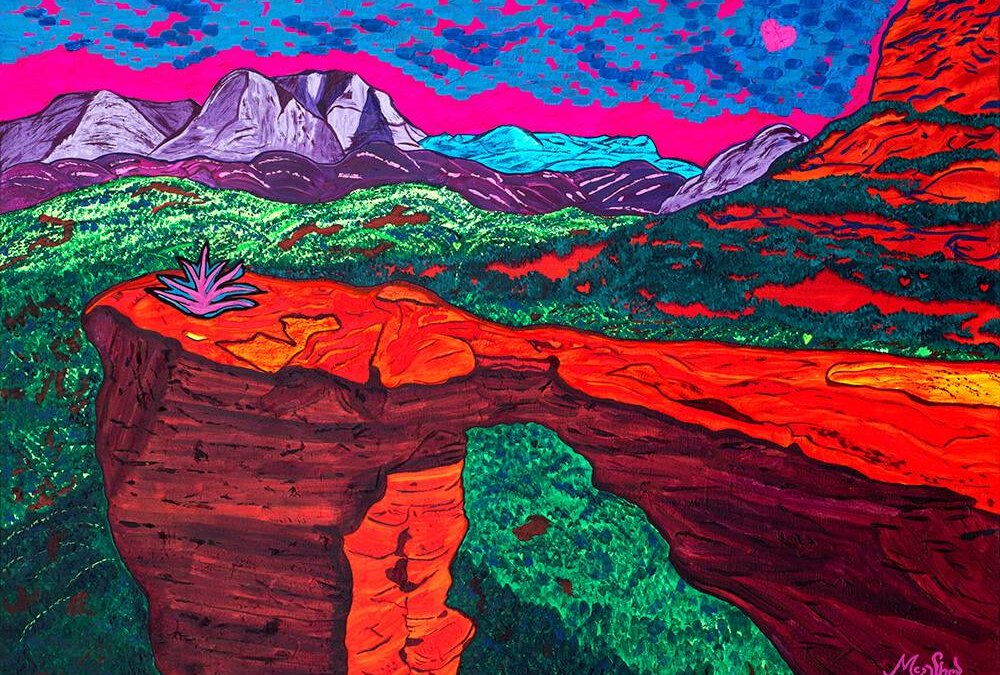There are hikes you remember, and then there are hikes that remember you. Devil’s Bridge belongs to the second group. Sedona’s largest natural sandstone arch is more than just a trail destination; it’s a threshold. Standing atop it, you feel suspended between earth and sky, balanced on a line of stone that has watched the desert breathe for ages. My painting, Devil’s Bridge, is my attempt to capture that breath—its hush, its thrill, and above all, its light.
When I started this piece, I turned to fluorescent acrylics because they let me paint not just the colors I saw, but the energy I felt. In daylight, the palette hums with pinon greens, ember oranges, and high-desert blues. These colors already carry Sedona’s warmth, but I wanted the painting to hold something more—something you could almost step into.
Under black light, the original reveals a secret: a luminous 3-D glow. The agave in the foreground appears to lift forward, the trail pulls the eye inward, and the arch itself gains a sculptural presence that feels tangible. That dimensionality is one of the gifts of fluorescent acrylics. They allow a painting to have two lives: one by day and another at night.
As with many of my works, I hidden hearts into the landscape—nestled in trees, etched into stone. They’re not obvious, nor are they meant to be. I place them like hikers leave small cairns: quiet signs for those who come later and take the time to look carefully. For me, these hearts are acknowledgments of love—our love for the land, and the love the land returns when we notice it.
Collectors often choose Devil’s Bridge for rooms where people gather. In living rooms, great rooms, or offices, it becomes a strong centerpiece that glows without overwhelming. Reproductions on canvas gallery wraps and luminous metal prints preserve the layered depth remarkably well, echoing the arch’s sense of balance and scale.
Those who have stood on the real arch tell me the painting rekindles memories—the cool air, the thrill of stepping out, the vastness of the view. Those who haven’t say it makes them want to lace up their boots and experience Sedona’s heights firsthand. Either way, the painting does its job: it conveys the feeling of being suspended between earth and sky, a moment that belongs to both place and memory.
This piece naturally pairs with Cathedral Moon—two stories of Sedona’s stone under luminous skies, one rendered in oil, the other in glowing acrylics. Together, they embody reverence for Sedona’s rock formations, while offering two distinct moods: the calm hush of moonlight and the energized hum of a desert day-to-night.
It also sits comfortably beside Sedona’s Hypnotic Earthrise, a work that takes the same sense of suspension and bends it toward the cosmic, placing Earth above the horizon. With Devil’s Bridge, the feeling is terrestrial but no less expansive. These works together outline what I love most about Sedona: it can be both intimate and infinite.
At its core, Devil’s Bridge is about perspective. Standing on the real arch is to feel both small and infinite, grounded and airborne. That’s the paradox Sedona offers, and that’s what I wanted the painting to express.
For me, the fluorescent glow beautifully captures that paradox. In daylight, it’s a vivid Southwest landscape, full of color and texture. Under black light, it becomes almost sculptural—inviting, dimensional, alive. The hidden hearts remind us to look closer, to love the land as it is. The agave glows as if lit from within, anchoring the foreground as a desert guardian. The arch, timeless and patient, spans the scene, an emblem of balance.
In the end, Devil’s Bridge reminds us that some vistas can’t be kept; they must be shared. Painting it was my way of inviting you up to the arch—to feel the air, see the light, and carry that view home.
Explore Devil’s Bridge and the full Top Nine collection here

